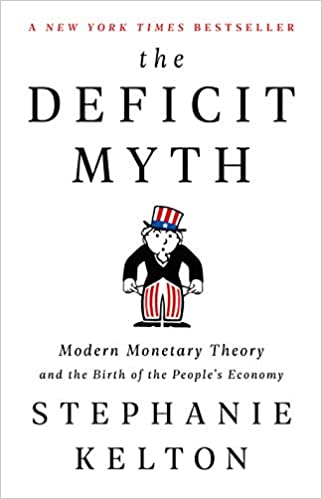You have /5 articles left.
Sign up for a free account or log in.
 The Deficit Myth: Modern Monetary Theory and the Birth of the People's Economy by Stephanie Kelton
The Deficit Myth: Modern Monetary Theory and the Birth of the People's Economy by Stephanie Kelton
Published in June 2020
Before I talk about The Deficit Myth, I want to credit Matt Reed for the motivation to read the book. There is a direct line from Matt’s riffing on The Deficit Myth in his June 15 piece "A Productive Mashup" to my buying and reading (well, listening) to the book. I doubt Matt will get a cut of the money I spent buying (downloading) the book, but he should.
Will the recommendations of two Inside Higher Ed bloggers inspire you to read The Deficit Myth?
Are you a candidate to engage with the arguments that Stephanie Kelton, professor of economics and public policy at Stony Brook University and former chief economist on the U.S. Senate Budget Committee, makes in The Deficit Myth?
There are three reasons why you might consider taking the time to read this book.
First, if you are worried about the federal budget deficit ($3.7 trillion) or total public debt ($26.6 trillion), you should read The Deficit Myth.
Second, suppose you want to arm yourself with a theoretical framework to argue for more federal investment in higher education (or COVID-19 relief) or any other public good (Green New Deal, anyone?). In that case, you should read The Deficit Myth.
And third, if you want to learn how to make a big persuasive book-length argument, you should read The Deficit Myth.
On the first two points, The Deficit Myth is genuinely mind-blowing. Kelton, a leading Modern Monetary Theory (MMT) theorist, tells us that when it comes to government spending, both liberals and conservatives worry about the wrong things. From an MMT lens, what matters is not debt, but inflation.
As a currency issuer, the U.S. government can never go broke. The metaphor of household budgeting that we use to guide spending, that we should not spend more than we earn, should not be applied to a nation with a sovereign currency. The only limitation on government spending is inflation, a situation where too few dollars are chasing too few real goods and services. As long as inflation is kept in check, year-to-year budget deficits and accumulated debt matter little.
Wait, there’s more. The idea that the government collects taxes to fund its operations. Wrong. The government prints money (actually conjures digital money into existence) to pay for everything it does. Spending comes first; taxation comes later. Taxes are a means of ensuring that the economy creates goods and services to buy (how individuals and companies pay their taxes) and to redistribute income. Taxes are not required to pay for government. I know, mind-blowing.
MMT offers an important lens during COVID-19. The theory tells us that what is important is not money, but the real productive capacity of the economy. This productive capacity is governed by how many goods and services can be produced, given the talent and energy of the people in the U.S., and the amount of raw materials and land, and other inputs. With the pandemic depressing economic opportunity, there is lots of room for the federal government (the currency issuer) to run large deficits to get money into the hands of people.
Don’t buy the argument? If you are skeptical (and I’m still skeptical), give the book a chance.
Which brings me to the third reason to read The Deficit Myth.
Kelton does much right in the persuasiveness department, and some things wrong. The big thing she gets right is in the way she structures her book around our current beliefs. In addressing our current understanding of how the world works -- interpretations she identifies as myths -- Kelton leads us step by step toward a new understanding of how federal spending works.
Where The Deficit Myth comes up short is not in its explanation of Modern Monetary Theory, but in the policy recommendations that follow from the theory's core ideas. The central policy that the book promotes is a universal jobs program. A guaranteed federal job. This policy may be a good or a bad idea (I’m going with bad), but it is surely not the only policy space that MMT opens up.
The reason that I don’t like the federal job guarantee is that I’ve spent my share of time working in not so great private-sector jobs. Would I have worked in the fast-food industry if I had the choice of taking a guaranteed federal job, one that I could not be fired from? Likely not. Kelton spends little time addressing the challenge of future labor shortages (an aging population) and the labor market crowding-out effect of a guaranteed federal jobs program.
This blog post is not the place to debate the merits of a federal guaranteed jobs program. Instead, my point is that in choosing to focus on a single policy solution in relation to the ideas of MMT, the theory becomes less persuasive. The Deficit Myth would have been a more convincing book if the theory was tested against a broad array of policy ideas, rather than a narrow set of proposals.
If MMT is right, however, the constraints for federal investments in higher education are more imaginary than real. MMT tells us that the federal government could fund higher education today with the same vigor and commitment as it did during the Sputnik era. What might higher education look like with abundant funding?
What might change if student debt could be swapped for a commitment to work in human services and other social sector jobs?
Could investments in education result in both low unemployment and a more productive and fairly distributed economy?
Can you imagine if the federal government invested in community colleges how it now invests in aircraft carriers and fighter jets?
From now on, after reading The Deficit Myth, I will certainly spend less time worrying about the federal debt. In that way, this book has been highly persuasive.
What are you reading?








